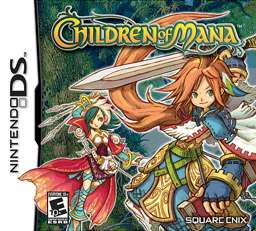Children of Mana

Part of the Mana series, released for the Nintendo DS in 2006.
The story focuses on the World Tree central in the shared settings: after a crack appears in it, the nearby temple suddenly becomes infested with monsters. After the player character clears out the temple, they return to find that mysterious pillars of light have appeared in numerous different lands...
Like other games in the Mana series, it uses an action RPG formula. It uses a top down perspective similar to the 2D The Legend of Zelda games, but with a heavier emphasis on combat, and a more defined system of giving you quests and sidequests. More RPG than Action if you will.
It's also a very divisive game. It's not as overtly reviled as Dawn of Mana or Heroes of Mana, but many find the gameplay repetitive and boring. Basically, it's Shining Soul, set in the World of Mana.
- The Blade Always Lands Pointy End In: In the opening sequence.
- Check Point Starvation: You get the option to equip new gear, manage your gems, and save after defeating four levels of a dungeon. Considering how many Hit Points the Damage Sponge Mooks possess, and their sheer quantity, coupled with the frequency in which your goal for the level involves killing all enemies, it can take upwards of half an hour between checkpoints.
- Chest Monster: Exploding ones.
- Continuity Nod: The "Benevodons" are actually the God-Beasts from Seiken Densetsu 3 in their normal non-rampaging states. they even have the same names.
- Disc One Final Boss: So, you beat the Mana Storm, the Mana Surge is stopped, so that's it, right? Wrong!
- Okay, but now you beat the Mana Lord, so that's gotta be the end! Well, it isn't.
- Drop the Hammer: One of the four weapon types.
- Fragile Speedster: Tamber
- Global Airship: You get it surprisingly early for a World of Mana game. This is mostly due to the world map being a glorified list of dungeons for you to enter, making the existence of a Global Airship at all a narrative device as opposed to a game design decision.
- Ice Palace
- Interface Spoiler: Even before clearing the first dungeon, you can see that you have room for four seperate weapon types and room for a gem grid four times larger than what you start with.
- Item Crafting: The gems
- Jack of All Stats: Ferrik
- Kenji Ito: Composed part of the music.
- Kid Hero: Ferrik, Poppen, and Tamber.
- Limit Break: The Fury meter.
- Mighty Glacier: Wanderer
- Pinball Projectile: Any enemy hit by the hammer will be knocked back and into nearby walls, taking damage with each hit. If that enemy hits another enemy, they both go flying. If a pinball enemy hits the player character, you become the projectile. Given how many other objects you need to hit with the hammer, it's a toss up whether you save time switching weapons every few seconds or just spending half of your time as a pinball.
- Shifting Sand Land
- Spikes of Doom
- Squishy Wizard: Poppen.
- Stationary Boss
- Super Dickery: The opening scrawl says how this is the story of the one time the Mana Sword was used against Mana.
- Sword of Plot Advancement: Acquired at the end of the first dungeon. For some reason, nobody thinks it'd be a good idea to use the peerless holy sword to attack monsters with.
- You Gotta Have Blue Hair